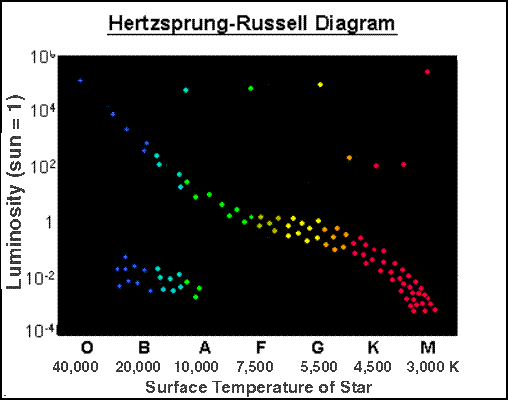

When patterns develop on a graph, they do so for a reason. The questions early astronomers asked were:
Why do stars insolate themselves in these groups?
What is the common link between all main sequence stars (of which the sun
is a member)?
What is the difference between main sequence stars (to produce the
distribution)?
In the last unit, we covered the energy source for the sun - nuclear fusion. This is a process where 4 hydrogen atoms are converted into 1 helium atom plus energy. This process occurs in the core of our sun and has been doing it for about 5 billion years. This is the common link between all main sequence stars, .... H → He fusion in their cores.
It is this fusion that is able to keep a star so stable for so long. Think of the fusion in the core as an incredible number of hydrogen bombs going off every second (because that is exactly what is happening). These reactions are trying to make the star expand or blow apart. However, gravity is also acting on the gases to draw them closer to the core. A star exhibits a beautiful balance between these two conflicting forces.
However, there needs to be some major differences between stars to account for the wide range of luminosities and temperatures we see on the main sequence.
Physics tells us that there are two ways to fuse hydrogen into helium. One process is known as the p-p chain (I'll leave out the details) and the other is called the CNO cycle. If the pressure and temperature is very high (many 10's of millions of degrees), the CNO cycle dominates and represents the most efficient method of conversion. However, if the pressures and temperatures are lower (a few 10's of millions of degrees), the p-p chain reaction is the only way to fuse the hydrogen. This is a less efficient conversion but it is still fusion. Can you guess which stars on the main sequence are fusing with the CNO cycle and which are fusing with the p-p chain reaction? The question now becomes, what factor(s) dictates which style of fusion reaction dominates in the core of a star? The answer is mass! The initial mass of a star dictates the entire fate of a star, ... what kind of fusion dominates, how long it can sustain the reaction (its lifespan), and how it dies. Stars with more mass are able to exert much greater pressure on a much larger core than a star with a much lower total mass.. This, along with a higher core temperature, means that CNO fusion dominates over p-p chain reactions. As a result, high mass stars are much hotter than low mass stars. In addition, high mass stars are larger than their low mass counterparts. This means these massive stars will be very luminous, ... showing up in the upper left corner of the main sequence. Low mass stars have low core temperatures and pressure, ... meaning p-p fusion dominates. Low mass stars are also smaller. As a result, these stars do not put out much light and show up in the lower right corner of the main sequence. By the numbers, it looks like nature favors the formation of low mass stars.
Astronomers have discovered stars that are hundreds of times the mass of the sun (>100 * Sol). The lowest mass is about 8% the mass of the sun (.08 * Sol).
|
|
|
Our sun has been fusing H → He in the core for about 5 billion years and will be able to continue doing so for another 5 billion years. That is, our sun's "fuel tank" is about half full (or half empty). Our sun's main sequence lifetime of 10 billion years is dictated by its mass. The more massive the star, the quicker it goes through its hydrogen "fuel". For example, an eight solar mass star will have a main sequence lifetime of 100 million year. The most massive stars will run out of hydrogen fuel in a mere 10 million years. That might sound like a long time (compared to human life spans), but is just a flash compared to our sun.
It is nice when astronomers have some data to back their claims. By looking at clusters of stars and examining a plot of their HR diagram, astronomers see that the high mass stars are the first ones leaving the main sequence (as they run out of hydrogen fuel). Since all the stars in the cluster are approximately the same age (born at the same time), the point on the main sequence where they begin to evolve off (known as the "turn-off point") tells astronomers exactly how old the cluster is. Click here to see a pretty good explanation of this.

Low mass stars hang around for a very long time. The estimated life span (based on theory) of a low mass star on the main sequence is about 50+ billion years. Why do I say estimated? The entire universe is just under 14 billion years old. Therefore, our universe is not old enough for any of these stars to have run out of fuel. The point you want to remember is that high mass stars have very short lifespans and low mass stars have very long lifespans. Our sun is somewhere in the middle in terms of these two extremes.
However, before we talk about what happens to a star when it runs out of hydrogen fuel, let's first discuss how a star forms in the first place.
Space is filled with clouds of gas and dust known as nebulae. These are vast regions of (mostly) hydrogen gas. Just surf over to Astronomy Picture of the Day and type in nebula in their search criteria. You will find hundreds of beautiful images of bright nebulae. These give off light because they either reflect light from nearby sources or by absorbing radiation from stars and then reemitting the energy (remember the bright line spectra?). Look at the image below (of the Horsehead nebula). It is a reminder that not all the gas emits light. There are regions in our galaxy where giant, dark regions of gas accumulates. These regions are known as cold molecular clouds, and astronomers have located thousands of them. They find them (even though they are dark) because cold hydrogen emits radiation with a wavelength of 21 centimeters. Radio astronomers, therefore, have no problem finding them.
Why do we bring up these vast regions of gas and dust? Nebulae are the birthplaces for stars. In fact, the gas and dust act as raw material from which the stars are made. All you need to do is get a local region of the nebula dense enough, ... and gravity takes over. The gases "condense" to smaller and smaller volumes, until finally the central temperature is high enough to initiate nuclear fusion. When that happens, the star is born. One nebula can give birth to hundreds or even thousands of individual stars.
|
credit NASA Notice the region of active star formation. Click these links to see more examples:
http://antwrp.gsfc.nasa.gov/apod/ap030503.html |
The Horsehead Nebula credit NPS |

Formation of stars (animation)
The internal pull of gravity eventually caused a collapse of a nebulae. Just as water "beads up" due to the internal attraction of water molecules, gas in a nebula also "beads up" into individual lumps which eventually become stars.
Astronomers can see star formation at all different stages of the process.
As stars form from the collapse of gas and dust within the nebula, they may also eject gas in the form of "jets". This process is not well understood, but definitely is one way for the young star to lose some mass in the very early formation stages. You will soon see that other objects produce these strange "jets".
|
Credit: J. Hester (Arizona St. U) et al., WFPC2, HST, NASA Notice the "jets" emitted from this nebula. |
As gravity takes over and the nebula contracts, it "beads up" and exposes individual disks of material. The gas is in the final stages of collapse and has been given the name proplyds (short for protoplanetary disks). Think of each proplyd like a "cocoon" for a future solar system. Below is a image of 5 future stars.
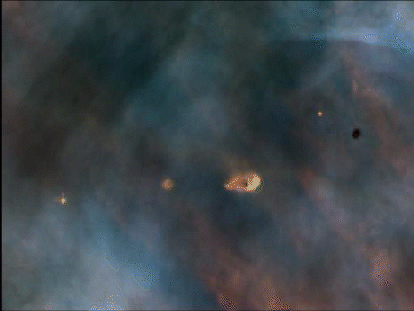
Credit: C.R. O'Dell (Rice U.), NASA,
The following text is directly from APOD: Of the five stars in this field which spans about 0.14 light-years, four appear to have associated proplyds - three bright ones and one dark one seen in silhouette against the bright nebula. A more complete survey of 110 stars in the region found 56 with proplyds.
Most of the gas and dust gravitate towards the center of the system ... heating up to the fusion point. A star is born! Not all the material falls to the center. A flat accretion disk forms perpendicular to the axis of rotation. The image below is the young star, Beta Pictoris. This star (in the center and not seen) has an accretion disk (a flat disk of debris surrounding the star). This remaining material will become the building blocks for planets. Most all young stars show the same thing .... meaning planetary systems around stars are quite common. This has since been confirmed by the steady discovery of exoplanets (discussed earlier).
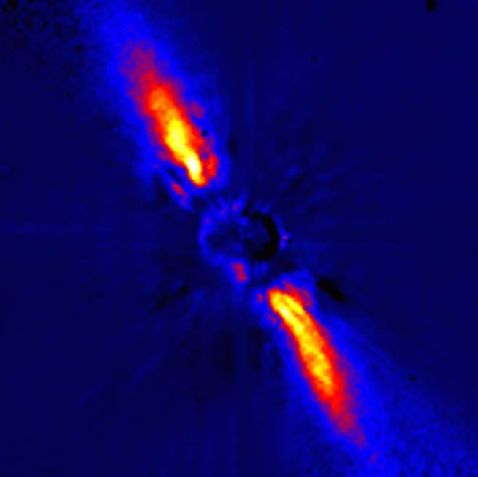
Beta Pictoris
Credit: J.-L. Beuzit et al. (Grenoble Obs.), ESO
The end product of a gravitationally collapsed nebula is a closely grouped "patch" of stars known as an open cluster. A perfect example is the nebula known as "The Seven Sisters" or the Pleiades. Another great example can be found here. Open clusters can produce anywhere from about 100 to 10,000 stars. In time, the stars disperse from the cluster and blend in with the general population of stars. For example, all of the stars of the Big Dipper were formed at the same time from an open cluster and are in the process of dispersing. It is easy and fun to randomly scan the night sky for open clusters with a pair of binoculars. Now that we understand the past history of our sun, we can turn our attention to the future of our favorite star.
Examine the HR diagram and notice that the main sequence is not a thin line, but rather, has a definite width (at least near the sun). As our sun continues to convert H → He in its core, it will move slightly on the HR diagram. It will migrate to a slightly higher luminosity (and also a slightly lower temperature) because of minor changes in the core. Note: This is only a very slight shift on the HR diagram. It will remain on the main sequence and not move very far from its initial appearance. In a nutshell, the core is slowly changing its composition (H to He), ... which produces a gradually shrinking core, .. which means the temperature gently increases, .. which means the rate of fusion goes up, .. which makes the sun more luminous, and also pushes the photosphere to a greater radius, ...which makes the surface cooler. Ok, so what does this all mean to us? Quite a bit, actually. The early sun was perhaps 30% dimmer in the past and will be perhaps 30% more luminous in the distant future. Will Earth be able to withstand this change and still harbor life? Some astronomers predict that in a mere 1.5 billion years, the earth's oceans will boil away and we will become a Venus. If humans are still around, we will need to find a new home.
In 5 billion years, the core of our sun will completely run out of fuel (hydrogen). What happens next? Since there is no longer any radiation pushing outward, the force of gravity will force a contraction at all layers of the sun. This means that not only will the core (now all helium) shrink ... but so will all layers above the core. But this contraction just outside the (former) core is still mostly hydrogen, and it will heat to the point where it gets hot enough to start a fusion reaction. This fusion of hydrogen to helium takes place in a shell surrounding the old core of the sun ... giving our sun a new lease on life. However, the sun modifies its equilibrium in such a way that the outer layers are expanded to great distances, ... vastly increasing the diameter of the sun. It becomes about 100 time its present size, ... becoming a red giant in the process. Red Giants are actually quite rare,... making them fewer than 1% of all stars.
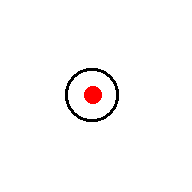
A Red Giant (animation)
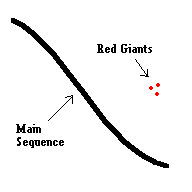
The bad news for Earth is, ... when the sun becomes a red giant, ... Earth is vaporized (and will most likely be swallowed up by the sun). Just in case you are thinking this is just theory, think again. For the first time astronomers saw this happen in real time when a red giant was seen swallowing up a planet. The announcement came in 2023 and you can read more here. The sun will remain a red giant for a few hundred million years (maybe less) until ...
Temperatures within the shrinking helium core become high enough so that even helium fuses. Yes, at high enough temperatures you can actually fuse 3 helium atoms into a carbon atom. This new energy source causes the core to suddenly expand outward ... which pushes on the upper layers ... causing the sun to eject a substantial amount of mass into space. We see this as an object known as a planetary nebula.

The ring nebula - a perfect example of a planetary nebula
Credit: H. Bond et al., Hubble Heritage
Team (STScI / AURA), NASA
Notice the exposed white dwarf in the center.
Here are some beautiful examples of planetary nebulae.
Helix
Nebula
The Ring
Nebula
Cat's Eye
Nebula
Butterfly
Nebula
Eight Burst
Nebula
Each of these images have something in common ... a small object is left behind after this "mini-explosion". It is the exposed core of the red giant. The planetary nebula phase was triggered by a "helium flash" in this core when it underwent fusion. Only this fusion was a fusion of helium to carbon. So this exposed core is a very hot ... dense ball of carbon atoms about the size of Earth. Technically it isn't really a star at all, ... because there is no fusion, but it is still called a star with the name white dwarf. When you heard the nursery rhyme .. Twinkle, twinkle little star ... how I wonder what you are, this object really is a "diamond in the sky". Astronomers are currently finding that about 10% of all "stars" are white dwarfs. The number may be even higher. White dwarf appear on the H-R diagram in the lower left corner.
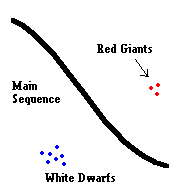
A white dwarf will slowly cool to a black dwarf. This marks the very end of our sun.
Before we end this section we need to address one last problem which relates to the formation of stars. Astronomers have known that any self collapsing object with a mass less than 8% the mass of the sun will not produce enough internal heat to initiate fusion. This object, therefore, will not become a star, but it can not be considered a planet either. These theoretical objects, dubbed brown dwarfs, should be a "missing link" between a star and a planet. Theory predicts that nature should make objects which remain gaseous and emit infrared radiation (which is generated by the heat of gravitational collapse alone). The only problem is that they would be very hard to detect. Finally, the first brown dwarf was actually found in 1995, and named Gliese 229B. Since then, several more brown dwarfs have been detected and the only question is, ... how many of them are out there?
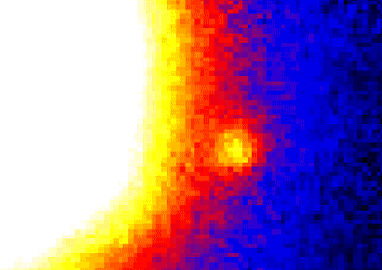
GL 229B: The first confirmed Brown Dwarf
Credit: 60-inch Telescope, Palomar
Observatory, T. Nakajima (Caltech),
S. Durrance (JHU)
ŠJim Mihal 2004, 2014- all rights reserved